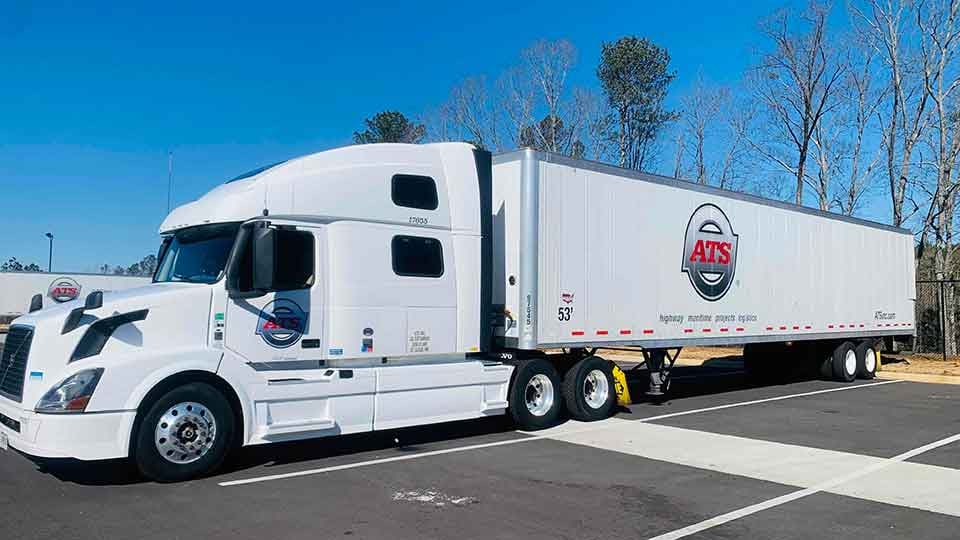Every day, millions of trucks travel the nation’s highways bringing goods to store shelves and customers.
Most of these trucks load at one point of origin, travel to a destination and unload. That’s considered one completed trip, and the truck and driver then pick up another load and repeat the process.
Sometimes, the driver has multiple destinations to make on the same trip. These multi-stop loads take more time and effort than single-stop loads, and carriers and brokers often prioritize single-stop loads.
As a shipper, it’s frustrating to have your loads rejected time after time. You are probably looking for ways to book multi-stop truckloads at an affordable price.
Anderson Trucking Service (ATS) has decades of experience in all types of shipping. Our experience working with shippers has taught us some valuable lessons for finding a carrier that can handle any type of load — even when the driver has to make multiple stops.
In this article, you will learn the factors that complicate multi-stop shipments for carriers and brokers, and how you can make your load more appealing. This information can help you book more successful transit.
The most common reasons carriers like to avoid multi-stop shipments are:
- Multi-stop loads mean lost drive time
- Multi-stop loads are more work for the driver
- Scheduling is difficult for multi-stop loads
- Multiple stops means rearranging freight at each stop
Multi-Stop Loads Mean Lost Drive Time
Drivers are paid based on the miles traveled each day, which are limited by government-mandated Hours of Service. On a good day, they can travel about 500 miles. To reach 500 miles, most of the day must be spent at highway speeds.
Multi-stop loads require the driver to stop or significantly slow down for much of the day. Loading and unloading time force the driver to burn driveable hours without getting paid.
Even between stops, the driver is likely to lose time. Exiting the highway, and especially driving through cities and towns, means traveling much slower than 50 miles per hour.
Making multiple stops means drivers are not making as much as they would on a more straightforward route. Many transportation providers will add an extra fee for each additional stop, which compensates the driver for their time.
Lost time is one reason drivers don’t like multi-stop loads. They also have additional tasks to do at each stop, which complicates the trip for them.

Multi-Stop Loads Are More Work for the Driver
More stops typically mean additional tasks for the driver, like securing the load or tarping multiple times.
In addition to the driveable hours lost, these tasks are heavy, complicated work. Especially on multi-stop loads, the driver may need to rearrange the freight and tarp multiple times. This inconvenience can be compounded by factors like bad weather.
Carriers and brokers are motivated to help drivers succeed and make as much money as possible. When a shipment becomes multi-stop, they charge more to compensate the driver for the additional tasks. Plan to pay an extra $50-$100 for each added stop.
One of a driver’s most important tasks is staying on schedule. This helps them make more money and benefits the receivers who receive their goods when needed. Multi-stop loads make this important task much more complicated.
Learn More: What Is Multi-Stop Truckload Shipping?
Scheduling Is Difficult with Multi-Stop Loads
Single-stop loads are fairly straightforward when it comes to arrival times. The driver sets a route plan for the day based on the number of miles and any special circumstances.
The route plan takes into account the allowed Hours of Service, as well as the time needed for drop-off and pick-up. Each additional stop complicates that daily schedule.
Every stop can cause delays (driver is lost, loading takes more time than planned, traffic delays on the way to the location) in addition to the slowdowns that can happen on the road.
If the driver is delayed at the first stop, all subsequent stops will be late. This can mean more wasted time if the driver arrives at a site after it’s closed, for example.
A simplified schedule is an advantage of single-stop loads. Scheduling is important in the trucking industry and every additional stop makes it more likely that the driver and carrier will not achieve their daily goals.
Multiple Stops Require Rearranging Freight at Each Stop
Freight is loaded or unloaded at each stop. This can put the trailer off balance — making it less safe during transit.
In a single-stop load, the trailer is loaded so that the heaviest freight is at the front of the trailer, closest to the tractor controlling the load. The truck is loaded front-to-back and unloaded back-to-front.
Multi-stop loads are more complicated. Depending on the order the freight needs to be dropped off or picked up, it’s unlikely that it can load and unload in the most efficient manner. If a single heavy unit is picked up later, it can involve rearranging the contents of the entire truck — meaning more lost time.
At each stop, the shipper is responsible for loading and unloading the truck. If staff is not there to load the truck efficiently, this is more drive time wasted in the day.
Sometimes shippers specify a multi-stop load instead of running a partially empty truckload. If your shipment will involve the truck traveling partially empty for a significant amount of time, it may be less expensive or more appealing to specify a different transportation solution, like less-than-truckload (LTL) shipping.
How to Make Your Multi-Stop Loads More Attractive to Brokers and Carriers
Carriers and brokers are hesitant to take on freight that will require multiple stops to load and unload. As the shipper, there are four basic steps you can take to make these loads more appealing to drivers and providers.
- Be thorough in your specification
- Be flexible with pick-up and delivery timing requirements
- Prepare for extra costs
- Consider the distance between stops
1. Be Thorough in Your Specification
In addition to the data usually required in a shipping specification, multi-stop loads require some additional information, including:
- Address of each destination. Give your provider an exact address for each stop on the journey. In addition, they will need to know if a loading dock is available, or how the truck will be loaded or unloaded at each site.
Providing an address is always required for a rate quote, but it’s even more important for multi-stop loads. This information will help the quoting agent determine the amount of time required each day and for the trip as a whole. - Dimensions and type of cargo in each location. The driver will need to know exactly what commodity is being picked up or dropped off at each site, as well as the size and weight of the individual pieces.
The driver needs this information to make sure the load is within legal limits at all times. Oversize freight, even for part of the trip, requires permits and route planning.
Accurately specifying the size and weight of the freight also helps the driver keep the load balanced, making it easier and safer to travel at highway speeds.
Including this information in your initial quote request will help your shipping partner create an accurate initial quotation, helping you plan your shipment and avoid surcharges later on.
2. Be Flexible With Pick-Up and Delivery Timing Requirements
As always in the transportation industry, flexibility is a tremendous asset.
Multi-stop loads especially require flexibility. The more stops in a load, the more opportunities there are for delays.
If subsequent pick-ups and deliveries have small windows of availability, it’s likely that the entire trip will be delayed. Larger, more flexible time windows will be easier for the driver and carrier to meet.
3. Prepare for Extra Costs
Multi-stop loads will cost more than single-stop loads. Expect to pay up to $300 for the second stop, and then $50-$150 for each additional stop.
This compensation is for the driver’s time spent driving to more locations and waiting for the truck to be loaded.
If more tasks, like tarping or driver-assisted loading, are needed at each location, there may be increased fees for each stop. These tasks take more of the driver’s time and effort, and the driver needs to be compensated for that time and care.
4. Consider the Distance Between Stops
The distance between stops is another factor that will influence the price and appeal of your load.
Multiple locations within one city or a small radius mean the driver has an increased chance of making appointment times, and they may be able to complete the entire trip in one or two days. Shorter loads are often more appealing so the driver can be home.
Longer loads, where the driver has to travel cross-country and make several stops along the way, require the driver to be away from home longer. The entire load is more complicated overall. This type of load isn’t as attractive to drivers.
Book More Multi-Stop Trucking Loads
Multi-stop loads present unique challenges and complexities for carriers and brokers in the trucking industry. These challenges include lost drive time, additional work for drivers, scheduling difficulties and the need to rearrange freight at each stop.
As a shipper, understanding these challenges and taking proactive steps to address them can make your multi-stop loads more attractive to carriers and brokers. Taking some time to evaluate your budget, flexibility and expectations can go a long way toward booking your next load.
The ATS Learning Hub consistently offers tips for booking successful shipments. If you’re looking for a quote, our experienced team is happy to help.




